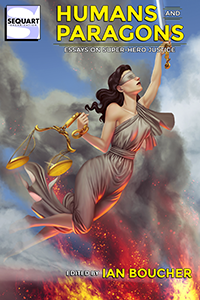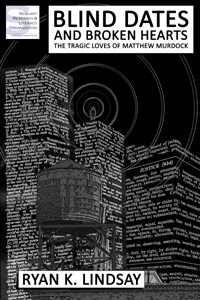The Joker laughs manically as he holds Batman, supposedly dead. Despite the large amount of blood on the weapon and on Batman, this isn’t even the shocking part. Exploding with delight, the Joker explains that the best part is that he got to kill his arch-enemy in front of a captive crowd of “vulnerable, disabled children.” And this is just the first three pages of Morrison’s start on Batman #655.
First off, what an odd thing to say. Second, what a odd thing to do. The fact that the Joker is using children as a captive audience is, or should be, shocking. But what should be significant to the reader is the specificity of the claim. Not just children, but specifically “vulnerable” and “disabled” children. As if Grant Morrison and Andy Kubert are showing the effects on the readers of how dark mainstream comics have become. After all, in our youths, these were aspirational figures, as Morrison himself would say. People we could pretend to be so we could be the best version of ourselves.
But what happens to us when we watch our idols die? Or when we get to see in almost pornographic detail our hero paralyzed, his back smashed beyond healing?
We have been brutalizing our idols to the point of redundancy. We have also been doing it since we were kids, which surely anyone would agree can be damaging on some level.
The modern super-hero character, regardless of how dark their reality became, was still an aspirational model. While you can never truly be Captain America, you can still aspire to be that type of person: a good guy, who says the right things and makes the right choices.
When we pull back all the layers of anything, we will find mold, disease, and dysfunction. Morrison’s run on Batman was an attempt to stop these living autopsies from continuing. Early in Batman #655, Commissioner Gordon is shown recovering in the hospital. The night prior, he had been sprayed with Joker’s neuro-toxin, causing temporary insanity.
In one panel, the Commissioner looks towards the reader, breaking the fourth wall, and announces: “Everybody needs to lighten up.” His face is all slack, resembling a victim of palsy. Morrison, via Kubert, is showing the reader that this has gone on too long.
I am not entirely sure if Morrison’s run on Batman fulfilled what could be perceived as a promise. Morrison was off to take Batman back to a more adventure-focused time.
But at the time, this new direction hurt Morrison’s profile in the comic world. Morrison mentions it in the back of the intro for Mark Waid’s Irredeemable. If Morrison is pigeon-holed as a writer of the weird, then Waid is pigeon-holed as a writer of fun, lighter super-heroes. Morrison complained of this categorizing in the letter, saying that neither man can seem to escape it.
Instead of trying to appeal to the whole of comics fandom, both writers have set off in new directions, both fulfilling Morrison’s directive via Commissioner Gordon. Everyone did need to lighten up, and these men would help lead the way.
 For Waid, we see this recently with his launch on Daredevil. From the cover alone, we are shown a fresh take on a character that had become too dark. In what looks like a Gene Colan-inspired cover, Paulo Rivera has Daredevil mid-leap. Surrounding the character is a world made of sound effects. Objects, buildings, animals, etc. are all outlined and filled in with blocks of words for the sounds they make or the sound bouncing off the object.
For Waid, we see this recently with his launch on Daredevil. From the cover alone, we are shown a fresh take on a character that had become too dark. In what looks like a Gene Colan-inspired cover, Paulo Rivera has Daredevil mid-leap. Surrounding the character is a world made of sound effects. Objects, buildings, animals, etc. are all outlined and filled in with blocks of words for the sounds they make or the sound bouncing off the object.
The cover shows that this Daredevil is a re-direction from its past. Instead of focusing on the crime syndicate aspect or super-hero identity, it focuses on his experience. What is it like to experience the world in such a significantly different way?
These are creators who want to go out into the world, not catalog how shitty it has become. They want to show you fantastic things like man-bats or lame / weird villains with cool powers like the Spot.
This is not just fantasy for fantasy’s sake. They are attempting to make something fun again that has been as dark as some cop shows on TV — watch 10 minutes of Law and Order: SVU, that is about as bleak as it comes.
In the back of Daredevil #1, Mark Waid gives a short tale of Murdoch catching up with his friend Foggy Nelson. Foggy is obviously uncomfortable with Matt Murdoch’s new and happy outlook. In what could be a big insult to continuitists, Mark Waid has Matt explain it to Foggy: “It has been a miserable last few years. And every time I thought I had hit bottom, God somehow found me a bigger shovel.”
Foggy’s retort, perhaps much like the readers response to the changes is a simple: “I’m not sure…”
And much like the reader, this is all fresh and new to his oldest friend. It isn’t that they want to push the reader off. It is more that as true creators they want the ability to travel down roads we may never consider for these characters. Writers like Waid and Morrison are not just driving down new roads though. They are changing the geography of these characters in new, emotional ways.
Waid is highlighting the emotional and personal tragedy that had been the main focus, not only on Daredevil but echoing what Morrison was saying back in Batman #655. We have let the creators beat our idols in front of ourselves and our children. This is not a plea against violence, this is a plea against bad writing. Focusing solely on navel gazing and crying is not a story.
Many stories from Marvel and DC have become more about histrionics than actual events. Going against this trend, writers like Morrison and Waid seem ready to fill each issue with as much going on as they can. Not because they have to, but because they want to. They love comics as much as any of us — perhaps a bit more than us. This applies to every page they write. They don’t want to give you an exegesis on the perils of modern consumerism or how cities are hotbeds of crime. They want to give you fun. Excitement. Adventure.
Instead of looking deep into the past of each character for a new hook that is so disturbing that people will keep reading, writers like Waid and Morrison offer up a new / old alternative. Give the readers a story with characters that are a bit more than us. Characters that we can aspire to. Not to say our real life heroes aren’t enough. But in our own dark times, we need goals, things to keep crawling towards, no matter how much we want to stop. This is what Waid and Morrison hope they are giving us. If not that, then maybe a story that will make you forget your problems for a few pages.
Or we could continue to torture our idols into nausea. Here is to hoping stories win out.




































































“If Morrison is pigeon-holed as a writer of the weird, then Waid is pigeon-holed as a writer of fun, lighter super-heroes.”
Well, Waid is proving us all wrong in Irredeemable. I’ve read some issues and it doesn’t seem to mean anything more than “Superman goez crazy and kills the Justice League.” I love dark superhero comics, but I also think they’re no longer saying anything new or relevant. These days, I think it’s bolder and more creative to be light and fun, than to insist in being negative. So yes, I hope the new Daredevil makes a difference.